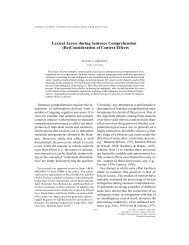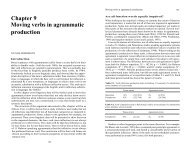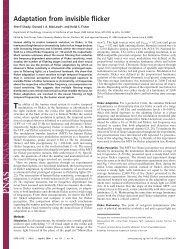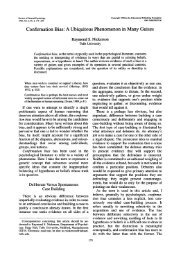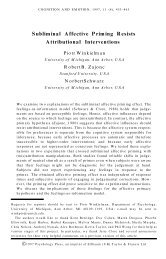128 ZURIF. SWINNEY, GARRETTwith our functional analysis. Thus, the agrammatics' relatively equal numberof errors on open- <strong>and</strong> closed-class targets may reasonably be viewed asreflect<strong>in</strong>g a disruption of the structurally relevant closed-class access <strong>and</strong>analysis route. <strong>and</strong> as the Wernicke's data make clear, this process<strong>in</strong>g problemis selectively tied to the overt features of agrammatism <strong>and</strong> not to theconsequences of bra<strong>in</strong> damage <strong>in</strong> general. 1It should be noted, however, that the Wernicke's patients did not performentirely normally on these tasks either. The pert<strong>in</strong>ent data <strong>in</strong> this respect arethose obta<strong>in</strong>ed <strong>in</strong> the scrambled word condition: As already remarked, thenormals showed much less of an open-closed class difference <strong>in</strong> this conditionthan they did with normal prose; by contrast, the Wernicke's patientsshowed very little shift from the pattern observed for them on the prosecondition. Their closed-class access <strong>and</strong> pars<strong>in</strong>g mechanism may, therefore,be hypothesized to be less than normally tied to the exigencies of <strong>in</strong>terpretivesystems. The effects of damage to the tissue implicated <strong>in</strong> Wernicke'saphasia may spare the ability to construct phrasal constituents (via theclosed class route, at least), but" these constructions cannot then be mappednormally onto semantically <strong>in</strong>terpretable levels. Alternatively, one may supposethat for normals the mapp<strong>in</strong>g is effected <strong>and</strong> rejected on <strong>in</strong>terpretivegrounds, but that this feedback <strong>in</strong>fluence is lost for Wernicke's patients.These last possibilities for Wernicke's raise the question: How can a devicethat provides <strong>in</strong>put to a parser persist <strong>in</strong> its operation when faced withunparsable (scrambled prose) passages? The answer we th<strong>in</strong>k turns on thenotion of impenetrability (Fodor, 1983; Pylyshyn, 1983): One facet of aform-driven or bottom-up device-of the sort that we characterized <strong>in</strong> ourdiscussion of the closed-class route-is that it accesses lexical <strong>in</strong>formation,but does not evaluate the context <strong>in</strong> which the item appears (nor, relatedly,1 Two earlier studies by Ross (1983) <strong>and</strong> by Locke <strong>and</strong> Deck (1982) us<strong>in</strong>g the st<strong>and</strong>ard letterdetection paradigm have been recorded <strong>in</strong> the literature. Our results differ from those of Ross,who reported the normal detection pattern for anteriorly lesioned patients; but our data are <strong>in</strong>agreement with those reported by Locke <strong>and</strong> Deck for a similar group. In both these otherstudies, however, the manner of patient classification makes the results difficult to <strong>in</strong>terpret <strong>in</strong>relation to agrammatism. Both studies dist<strong>in</strong>guish patients on the basis of lesion site-broadly,anterior versus posterior; <strong>and</strong> neither <strong>in</strong>dicated the degree to which the behavioral features ofagrammatism were present. It seems likely, then, that patient selection differences underlie thevariations <strong>in</strong> the outcome of these studies.In this respect, we cannot ignore the pitfalls of group research spelled out by Bade,:ker <strong>and</strong>Caramazza (1985). They question agrammatism as a coherent psychological entity <strong>and</strong> claim,on this <strong>and</strong> other bases, that the only proper manner by which to reach an underst<strong>and</strong><strong>in</strong>g ofthe mechanisms of language process<strong>in</strong>g is to analyze exhaustively s<strong>in</strong>gle aphasic cases. In ourview, it seems somewhat premature to assume what theoretical process<strong>in</strong>g dist<strong>in</strong>ctions ought tobe applied <strong>in</strong> the evaluation of a coherent theoretical entity. Rather, our best hope of form<strong>in</strong>gcognitively coherent categories-of bootstrapp<strong>in</strong>g our knowledge of agrammatism-is to formgroups on the basis of specific behavioral features of presumed theoretical relevance. Still, asmade abundantly clear by Badecker & Caramazza (1985), we can no longer afford to treat <strong>in</strong>terlaboratoryor even <strong>in</strong>tragroup variability as a r<strong>and</strong>om effect of no theoretical significance.
4. LEXICAL PROCESSING AND SENTENCE COMPREHENSION 129the semantic force of the item). On this view, contextual constra<strong>in</strong>ts applyafter the <strong>in</strong>formation has been accessed. Accord<strong>in</strong>gly, <strong>in</strong>itial access basedon word forms may be spared <strong>in</strong> Wernicke's aphasia, but because patientspresent<strong>in</strong>g with this syndrome have an <strong>in</strong>terpretation problem, they are unableto apply context-or more properly <strong>in</strong> the present <strong>in</strong>stance, lack ofcontext-to block local phrasal assignment efforts.But to return to the closed-class access device, itself: The data to thispo<strong>in</strong>t susta<strong>in</strong> a mechanistic account <strong>in</strong> terms of the operat<strong>in</strong>g characteristicsof a specific word access system-characteristics that show the system to bedist<strong>in</strong>guished normally from that underly<strong>in</strong>g open-class access; <strong>and</strong> thatshow it to be unalterable, <strong>and</strong> cognitively impenetrable (as underl<strong>in</strong>ed bythe Wernicke's patients performance). And on such an account, the agrammaticpatients' failure to contact closed-class word representations is notseen as some failure of stored representations, but rather as a process<strong>in</strong>gfailure-as a failure, presumably, to make these elements available at theright time <strong>in</strong> the process<strong>in</strong>g sequence.EXHAUSTIVE LEXICAL ACCESSIN SENTENCE PROCESSINGIn this section we cont<strong>in</strong>ue to explore the impenetrability of lexical access.We do so now, however, <strong>in</strong> a more direct <strong>and</strong> encompass<strong>in</strong>g fashion, br<strong>in</strong>g<strong>in</strong>gforth evidence that provides a somewhat different perspective on theagrammatics' failure to make normal use of a closed-class access <strong>and</strong> pars<strong>in</strong>gdevice.The study that we undertook-detailed elsewhere (Sw<strong>in</strong>ney, Zurif, &Nicol, 1989) <strong>and</strong> only summarized here-turned on the use of words withtwo or more mean<strong>in</strong>gs. These items provide a straightforward means of exam<strong>in</strong><strong>in</strong>gthe effects of context on lexical access: Simply, sentence contextcan be rigged to make one or the other mean<strong>in</strong>g of an ambiguous item relevant,<strong>and</strong> if lexical access were not contextually impenetrable, only the contextuallyrelevant sense of that item should be accessed. If, however, accessis impenetrable, then all mean<strong>in</strong>gs might be expected to be momentarilyactive. Clearly, this last claim is a time-dependent one. Context must eventuallyexert an effect-we do not normally experience enterta<strong>in</strong><strong>in</strong>g contextuallyirrelevant mean<strong>in</strong>gs of such words. Accord<strong>in</strong>gly, any <strong>in</strong>vestigation ofimpenetrability must depend on measures of lexical access as they unfolddur<strong>in</strong>g the act of comprehension.Such measures are termed on-l<strong>in</strong>e or real-time measures. They are notrooted <strong>in</strong> an assessment of the f<strong>in</strong>ished product, that is, <strong>in</strong> an assessment ofultimate success or failure of sentence comprehension. The letter detectionmeasure, on these grounds, is one such. For the ambiguous word study tobe reported, we made use of a different technique termed cross modal lexi-



